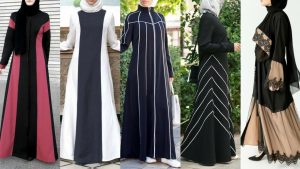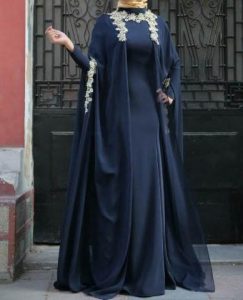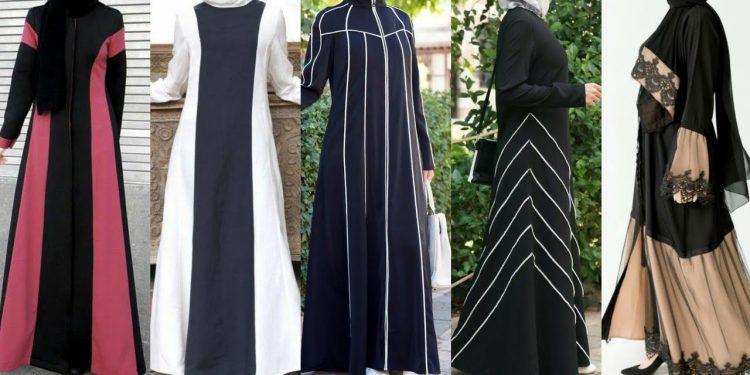People use clothing to enhance personal appearance and protect the body from extreme temperatures and elements in various climates.
Aside, a first impression is formed based on what a person wears.
Making sure that private parts of the body are covered is very important for maintaining a decent appearance in public in the majority of world communities.
Abaya is however one of the clothes, that ladies wear nowadays to serve as a covering from the head to the toe to protect the wearer from undue exposure.
An abaya is a long flowing robe that is usually loosely fitted and worn over everyday clothes.
It goes down to the feet and has long sleeves so the body is fully covered. Initially, abaya used to be in black colors, but over the years, they appear in colorful fabrics and styles.
In Qatar and all over the Middle East, a lot of indigenous women wear abayas.
In fact, it was a common sight in many other Muslim countries where women find it convenient and the best way to cover their bodies, leaving just their faces, hands, and feet exposed.
Findings revealed that the history of the abaya is rather vague and unclear, but it indicated that this robe-like garment has existed for more than 4,000 years.
Historical evidence points towards its use by ancient civilizations, especially the Mesopotamians wore clothing that was long and as loose as the abaya of today.
There is doubt though that, at the time, the garment was probably not known as the abaya.
With time, the abaya continued to evolve, and in the 1990s, though the basic style and shape of the abaya remained the same, more embroidery and decorations like lace, and stones that could be ironed on become a norm.
In the first decade of the 2000s, the experimentation of the abaya took on a new meaning with the introduction of many different styles and cuts, some too blingy, some over-the-top, and some even rather bizarre.
Some abayas had bats, butterflies, or anything that had wings.
Some abayas even had waistlines that were emphasized by different types of wide or narrow belts that accentuated the body shape and went against the rationale behind the abaya- to not show off the body shape.
All of this was done to blend in with the western style of dressing.
Today, the abaya is not just a body covering garment, it has transcended mere functionality and become an expression of individualism as well as acquired a standing of its own.
Abaya designers have taken the abaya to a whole new level with emphasis on global fashion trends along with an awareness of changes in the environment and the world in general.
The abaya industry has evolved just like the abaya itself.
Not only can you buy an abaya from various shopping malls, souqs, and bazaars, but now you can have them custom-made by an abaya designer which is becoming quite the trend in today’s world, especially among the elite.
However, Modern abaya dresses are often made from a solid color other than black.
The abaya can be any color and many Muslim women enjoy the fashion of wearing an abaya that looks more like a fashionable dress than an oversized cloak.
Although still modest, these fashionable abaya dresses may be embellished with elegant beads or embroidery, providing women with varied choices for their abayas.
Today, Abaya is seen as a piece of modest clothing for Muslims, but today it has cut across religions.
It is worn across the globe, especially in the Middle East, Malaysia, Indonesia, Turkey, India, and Pakistan, and among Nigerian women.
While initially, they were worn as all-black Burqas, they are now being redesigned and revamped to meet the fashion trends, as well as, the needs of the customers.
Various colors, designs, and embellishments are being incorporated to create stunning pieces.
When it comes to modest fashion, most women who cover-up, also opt for long western dresses that can easily act as Abayas.
Additionally, the latest trend calls for robes, cardigans, and long jackets to act as Abayas.
These different and modern styles are definitely gaining popularity among modern-day Muslim women.
Factors to Consider When Shopping for Abayas
Try out different colors and styles to see what works best for you.
You can always try out different Hijab looks with an Abaya.
Accessorize your look with brooches and belts.
Try incorporating all the latest trends with your Abaya.
Choose colors that are season-appropriate.
Invest in some pastel shades that look refreshing in Hot, Cold, and seasons like Spring and Summer as well.

Find Abayas that Work in every Setting
1. The first thing you need to do is read the label and find out if you should take your abaya to the dry cleaner or if you can care for it at home.
The label will also indicate the fabric composition; some abaya materials are a blend of natural and synthetic fibers, which is an important factor to consider when caring for an abaya.
For example, if there is silk in the mix, then that overlay needs to go to the dry cleaners without a second thought.
2. For everyday abayas made from crepe, hand wash them separately in cold water using delicate detergents that won’t wear down the material.
For dark-colored abayas, look for specialty detergents, such as the Persil Abaya Shampoo, to prevent the color from fading.
3. For the drying process, skip the machine dryer and let your abaya air dry.
Tossing your abaya into the dryer will expose it to extreme heat, which will cause the fabric to shrink and the colors to dull.
4. Be extra careful while pressing out creases.
Put your iron or steamer on the lowest heat setting and always make sure you’re ironing out wrinkles while your abaya is inside out.
5. Store your abayas neatly in your closet and out of direct sunlight to prevent the colors from fading.
6. Never hang your abaya or any article of clothing on wire hangers as that could ruin the shoulder shape.
We recommend using velvet or felt hangers so that your overlay stays in place and doesn’t drop to the bottom of the closet.
7. When shopping for an abaya, make sure the length is not too long so that it doesn’t drag on the ground.
Sweeping up dust with your abaya is never glamorous.
So, ladies keep them clean!
430 total views, 1 views today





